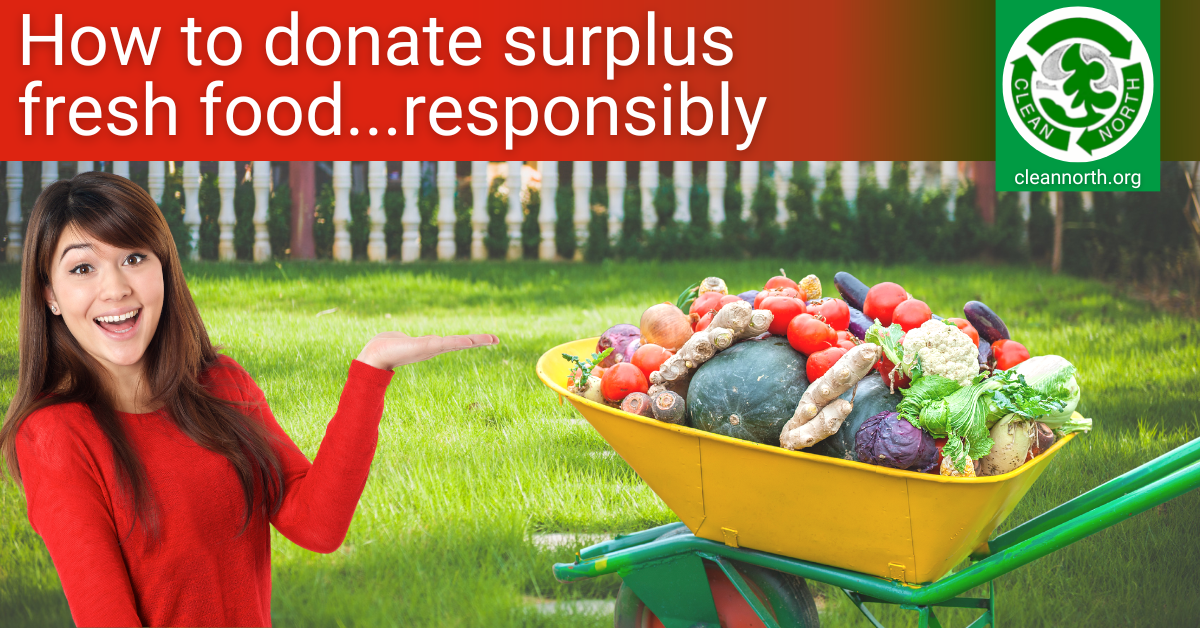
Got a landslide of lettuce, a torrent of tomatoes, a crush of cucumbers, or a zillion zucchinis? Want to share your bounty with someone in need but not sure how to do that? Donating perishable food can be tricky. If the timing is off, it may end up in the landfill. And that’s bad for the planet because in landfills, decaying food gives off methane, a super-powerful greenhouse gas. We offer tips to increase the odds of your fresh produce getting to people in need rather than ending up trashed.
Two key steps
- Make sure the receiving organization can use your produce (has staff/volunteers able to receive it and room to store it)
- Donate at the right time
For example, depending on the food bank, dropping off 30 heads of lettuce that are just past peak freshness on a Friday afternoon before a long weekend might be risky. They could end up in the dumpster the following Tuesday. But it depends on how full a given food bank’s fridges are and on what day(s) of the week they distribute. Fridays are actually a good day to donate lettuce and more tender veggies to St. Vincent Place on Albert St. E. because they give out food on Saturdays (as well as Wednesdays).
With more durable produce like potatoes, thick-skinned squashes (not zucchini!), onions, garlic, or apples, you can worry less about what day of the week you donate and whether the food bank has enough room in their fridge. These veggies have a long shelf life and don’t need to be refrigerated.
How to increase the chances of donated produce being used
Make a plan
- Decide where you will be donating (see list below).
- Call to get current information on the best day/time to donate. This varies depending on the food bank.
- Let them know what you are offering, how much, and whether it needs to be refrigerated. Food banks vary in their cold storage capacity, and that can change from week to week depending on donations coming in.
Harvest
- Pick your produce at the right time (not so green it won’t ripen but not overripe) and make sure what you are harvesting will remain edible for at least a few days after being donated. Pick tomatoes while still a bit green to extend their shelf life.
- Give anything likely to spoil in a day or two to a friend or neighbour or put in your composter. Or offer up surplus produce on a local Facebook group like Zero Waste Sault or Seeds of Change.
Prep
- Inspect produce for mold, bruises, insects, etc. Don’t donate it if you wouldn’t eat it. For example, zucchinis longer than 8-10 inches long are a problem because they are barely edible except as soup filler. And oversized green beans can be tough and stringy.
- Remove any soil. Root veggies are the biggest issue as they can be quite dirty when pulled out of the ground. You don’t have to scrub every bit of soil off them, but the less soil the better.
- Store harvested produce in your fridge in clean, food-grade containers or bags (except for ones that don’t need refrigerating—potatoes, tomatoes, sweet potatoes, acorn/butternut squash, garlic, onions).
- Keep produce types separate as some fruits/veggies emit gases that cause others to spoil faster.
- To reduce risk of foodborne illness, do not cut up produce before donating.
“Where can I donate fresh produce?“
Five options…again, usually best to phone first to determine need/capacity/hours:
- Harvest Algoma, 446 Second Line E. (705)253-0273, check office hours
- Connect the Dots, drop off on Saturdays at 1 pm at Algoma Farmers Market at Bondar tent and 2 pm at the Mill Market at 35 Canal Dr. (no need to call), Facebook page
- Soup Kitchen Community Centre, 172 James St., (705)942-2694, check office hours
- St. Vincent Place, 222 Albert St. E., (705)253-2770, check office hours
- Salvation Army, 78 Elgin St., (705)759-4143 (they will also pick up food!), check office hours
And again, local Facebook groups are another place to offer up free fresh food.
For agencies seeking food for clients…
If you work with a nonprofit/social service agency and are seeking food for your clients, we suggest you contact Harvest Algoma (hub for food and food preparation donations), the Food Bank Farm (grows food locally for people in need), or Connect the Dots (food rescue organization) to talk about how they might help.
Final note on food waste and climate change
We can’t stress enough the importance of keeping organic waste like fruits and vegetables out of the landfill. The anaerobic (oxygen-free) conditions in landfills results in organic matter giving off methane as it breaks down. Methane has many times the power of carbon dioxide when it comes to climate change. So if you can’t use produce yourself, give it away or compost it. Let’s do all we can to ensure food waste does not end up in the landfill.
Good luck, thank you for helping to prevent food waste and fight climate change, and enjoy your harvest!





One Reply to “Prevent food waste by donating garden produce responsibly”
Comments are closed.